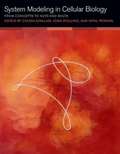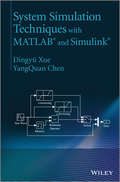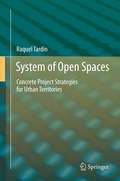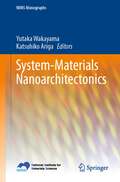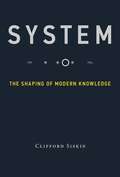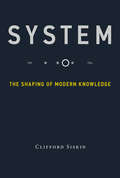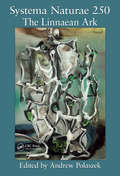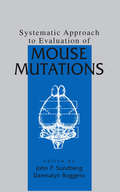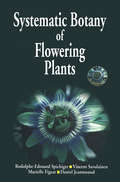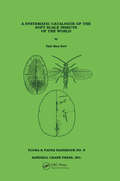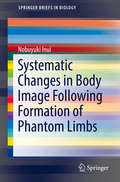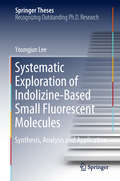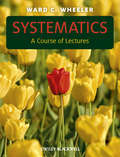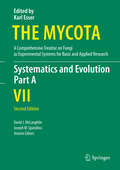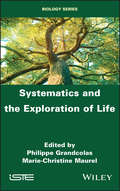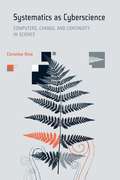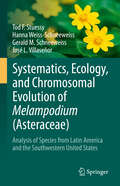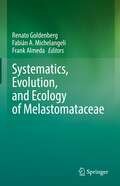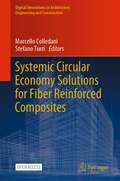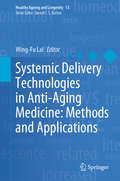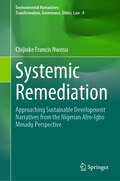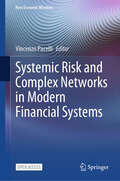- Table View
- List View
System Modeling and Optimization
by Christian Pötzsche Clemens Heuberger Barbara Kaltenbacher Franz RendlThis book is a collection of thoroughly refereed papers presented at the 26th IFIP TC 7 Conference on System Modeling and Optimization, held in Klagenfurt, Austria, in September 2013. The 34 revised papers were carefully selected from numerous submissions. They cover the latest progress in a wide range of topics such as optimal control of ordinary and partial differential equations, modeling and simulation, inverse problems, nonlinear, discrete, and stochastic optimization as well as industrial applications.
System Modeling in Cell Biology: From Concepts to Nuts and Bolts
by Zoltan Szallasi Vipul Periwal Jorg StellingResearch in systems biology requires the collaboration of researchers from diverse backgrounds, including biology, computer science, mathematics, statistics, physics, and biochemistry. These collaborations, necessary because of the enormous breadth of background needed for research in this field, can be hindered by differing understandings of the limitations and applicability of techniques and concerns from different disciplines. This comprehensive introduction and overview of system modeling in biology makes the relevant background material from all pertinent fields accessible to researchers with different backgrounds. The emerging area of systems level modeling in cellular biology has lacked a critical and thorough overview. This book fills that gap. It is the first to provide the necessary critical comparison of concepts and approaches, with an emphasis on their possible applications. It presents key concepts and their theoretical background, including the concepts of robustness and modularity and their exploitation to study biological systems; the best-known modeling approaches, and their advantages and disadvantages; lessons from the application of mathematical models to the study of cellular biology; and available modeling tools and datasets, along with their computational limitations.
System Simulation Techniques with MATLAB and Simulink
by Yangquan Chen Dingyü XueSystem Simulation Techniques with MATLAB and Simulink comprehensively explains how to use MATLAB and Simulink to perform dynamic systems simulation tasks for engineering and non-engineering applications.This book begins with covering the fundamentals of MATLAB programming and applications, and the solutions to different mathematical problems in simulation. The fundamentals of Simulink modelling and simulation are then presented, followed by coverage of intermediate level modelling skills and more advanced techniques in Simulink modelling and applications.Finally the modelling and simulation of engineering and non-engineering systems are presented. The areas covered include electrical, electronic systems, mechanical systems, pharmacokinetic systems, video and image processing systems and discrete event systems. Hardware-in-the-loop simulation and real-time application are also discussed.Key features:Progressive building of simulation skills using Simulink, from basics through to advanced levels, with illustrations and examplesWide coverage of simulation topics of applications from engineering to non-engineering systemsDedicated chapter on hardware-in-the-loop simulation and real time controlEnd of chapter exercisesA companion website hosting a solution manual and powerpoint slidesSystem Simulation Techniques with MATLAB and Simulink is a suitable textbook for senior undergraduate/postgraduate courses covering modelling and simulation, and is also an ideal reference for researchers and practitioners in industry.
System of Open Spaces
by Raquel TardinIn the current panorama of urban growth and planning in many urban territories of western societies, open spaces are residual spaces of urban occupation or are reserved for eventual occupation. Open spaces have been viewed in this manner in the earlier stages of the compact city and especially now, in a time of the dispersed territories characterized by discontinuity, heterogeneity, and fragmentation. The disciplinary perspectives of ecology, geology, landscape architecture, and urbanism, but also public opinion, have for some time promoted the conservation and protection of the most valuable natural spaces, and efforts have been made to remove such spaces from the real estate market. However, such positions, usually radical, are insufficient for territorial equilibrium and inevitably lead to the progressive disappearance of valuable natural spaces.
System under Stress: Homeland Security and American Politics
by Donald F. KettlFor the purposes of the study of American government, suggests Kettl (political science, U. of Pennsylvania), the 9-11 terrorist attacks and the Hurricane Katrina disaster were "stress tests" analogous to those run by a cardiologist to diagnose the health of a patient's heart. He offers his own diagnosis of the US government's homeland security health as revealed by these events, discussing intelligence failures prior to the 9-11 attacks and the government's response, broader coordination problems in the federal bureaucracy, state and local government responses to Hurricane Katrina, the policy problem of trying to maximize protection against threats that can't be eliminated, and the alleged conflict between security and civil rights and liberties. Annotation ©2007 Book News, Inc., Portland, OR (booknews.com)
System-Materials Nanoarchitectonics (NIMS Monographs)
by Katsuhiko Ariga Yutaka WakayamaThis book is the first publication to widely introduce the contributions of nanoarchitectonics to the development of functional materials and systems. The book opens up pathways to novel nanotechnology based on bottom-up techniques. In fields of nanotechnology, theoretical and practical limitations are expected in the bottom-up nanofabrication process. Instead, some supramolecular processes for nano- and microstructure formation including molecular recognition, self-assembly, and template synthesis have gained great attention as novel key technologies to break through expected limitations in current nanotechnology. This volume describes future images of nanotechnology and related materials and device science as well as practical applications for energy and biotechnology. Readers including specialists, non-specialists, graduate students, and undergraduate students can focus on the parts of the book that interest and concern them most. Target fields include materials chemistry, organic chemistry, physical chemistry, nanotechnology, and even biotechnology.
System: The Shaping of Modern Knowledge
by Clifford SiskinA system can describe what we see (the solar system), operate a computer (Windows 10), or be made on a page (the fourteen engineered lines of a sonnet). In this book, Clifford Siskin shows that system is best understood as a genre -- a form that works physically in the world to mediate our efforts to understand it. Indeed, many Enlightenment authors published works they called "system" to compete with the essay and the treatise. Drawing on the history of system from Galileo's "message from the stars" and Newton's "system of the world" to today's "computational universe," Siskin illuminates the role that the genre of system has played in the shaping and reshaping of modern knowledge. Previous engagements with systems have involved making them, using them, or imagining better ones. Siskin offers an innovative perspective by investigating system itself. He considers the past and present, moving from the "system of the world" to "a world full of systems." He traces the turn to system in the seventeenth and eighteenth centuries, and describes this primary form of Enlightenment as a mediator of political, cultural, and social modernity -- pointing to the moment when people began to "blame the system" for working both too well ("you can't beat the system") and not well enough (it always seems to "break down"). Throughout, his touchstones are: what system is and how it has changed; how it has mediated knowledge; and how it has worked in the world.
System: The Shaping of Modern Knowledge (Infrastructures)
by Clifford SiskinThe role that “system” has played in the shaping and reshaping of modern knowledge, from Galileo and Newton to our own “computational universe.”A system can describe what we see (the solar system), operate a computer (Windows 10), or be made on a page (the fourteen engineered lines of a sonnet). In this book, Clifford Siskin shows that system is best understood as a genre—a form that works physically in the world to mediate our efforts to understand it. Indeed, many Enlightenment authors published works they called “system” to compete with the essay and the treatise. Drawing on the history of system from Galileo's “message from the stars” and Newton's “system of the world” to today's “computational universe,” Siskin illuminates the role that the genre of system has played in the shaping and reshaping of modern knowledge.Previous engagements with systems have involved making them, using them, or imagining better ones. Siskin offers an innovative perspective by investigating system itself. He considers the past and present, moving from the “system of the world” to “a world full of systems.” He traces the turn to system in the seventeenth and eighteenth centuries, and describes this primary form of Enlightenment as a mediator of political, cultural, and social modernity—pointing to the moment when people began to “blame the system” for working both too well (“you can't beat the system”) and not well enough (it always seems to “break down”). Throughout, his touchstones are: what system is and how it has changed; how it has mediated knowledge; and how it has worked in the world.
Systema Naturae 250 - The Linnaean Ark
by Andrew PolaszekThe advent of relational databasing and data storage capacity, coupled with revolutionary advances in molecular sequencing technology and specimen imaging, have led to a taxonomic renaissance. Systema Naturae 250 - The Linnaean Ark maps the origins of this renaissance, beginning with Linnaeus, through his "apostles", via the great unsung hero Charl
Systematic Approach to Evaluation of Mouse Mutations
by John P. Sundberg Dawnalyn BoggessExperts from The Jackson Laboratory and around the world provide practical advice on everything from how to establish a colony to where to go for specific mutations. The book includes information on medical photography, grafting procedures, and how to map the genes and evaluate the special biological characteristics of mice. It also discusses how to maintain a colony of mice that breed with difficulty, how to approach mapping spontaneous mutations, how to set up systems to evaluate a specific antibody, how to perform simple measurements that yield a large amount of information, and how to access mouse informatics on the Web.
Systematic Botany of Flowering Plants: A New Phytogenetic Approach of the Angiosperms of the Temperate and Tropical Regions
by R E. SpichigerThe principle objective of this book is to describe a range of families of flowering plants in a sequence corresponding to current phylogenetic classification based on the most recent results of molecular systematics. The selection of families is large and comprises families of temperate European flora as well as tropical flora. They are integrated in their respective orders and keys are given to help the reader recognize them. Each family is richly illustrated, the identifying characters being shown as clearly as possible. A glossary complements the overall didactic qualities of this reference.
Systematic Catalogue of the Soft Scale Insects of the World
by Yair Ben-DovA catalogue of the soft-scale insects of the world (Homoptera: Coccoidea: Cocidae) with data on geographical distribution, host plants, biology and economic importance. This catalogue lists 162 genera comprising 1090 species and subspecies which have been described since Linnaeus (1758) until the cutoff date of December 1991. Extensive data are presented on taxonomy, nomenclature, synonyms, geographical distribution, host plants, biology, and economic importance of the species. New combinations are established for 40 species. One species, namely Filippia subterranea Gomez-Menor Ortega, is newly synonymized with Lecanopsis formicarum Newstead.
Systematic Changes in Body Image Following Formation of Phantom Limbs
by Nobuyuki InuiThis book presents new findings on body image and also introduces new neuroscience-based methods for the fields of neurology and neurorehabilitation. Even when the hand is stationary we know its position - information that is needed by the brain to plan movements. If the sensory input from a limb is removed as the result of an accident, or as part of an experiment with local anesthesia, then a 'phantom' limb commonly develops. We used ischemic anesthesia of one limb to study the mechanisms that define this phenomenon. Surprisingly, if the fingers, wrist, elbow, ankle, and knee are extended before and during an ischemic block, then the perceived limb is flexed at the joint and vice versa. Furthermore, the limb is perceived to move continuously with no default position. The key parameter for these illusory changes in limb position is the difference in discharge rates between afferents in the flexor and extensor muscles at a joint. The final position of the phantom limb depends on its initial position, suggesting that a body image uses incoming proprioceptive information for determination of starting points and endpoints when generating movements. In addition, the change in position does not involve limb postures that are anatomically impossible, suggesting that illusory posture is constrained by body maps. These results provide new information about how the brain generates phantom limbs.
Systematic Exploration of Indolizine-Based Small Fluorescent Molecules: Synthesis, Analysis, And Application (Springer Theses)
by Youngjun LeeThis thesis describes an in-depth study of an indolizine-based fluorophore, from understanding of its structure-photophysical property relationship to its application as a useful biological reporter.Organic fluorophores have been extensively used in the field of molecular biology owing to their excellent photophysical property, suitable cell permeability, and synthetic flexibility. Understanding of the structure-photophysical property relationship of a given fluorophore often paves the road to the development of valuable molecular probes to visualize and transcribe biological networks. In this thesis, respective chapters deal with molecular design, organic synthesis, structure-property analysis, and quantum-mechanical interpretation of unexplored family of indolizine-based molecules. This systematic exploration has led to rational development of a new microalgae lipid droplet probe, colorful bioorthogonal fluorogenic probes, and a bright mitochondrial probe, working under live cell conditions.Harnessing the optical properties of a given fluorophore has been an important topic for a couple of decades, both in industry and in academia. This thesis provides useful insights for the improvement and development of unique small fluorescent materials, or optical materials.
Systematics
by Ward C. WheelerSystematics: A Course of Lectures is designed for use in an advanced undergraduate or introductory graduate level course in systematics and is meant to present core systematic concepts and literature. The book covers topics such as the history of systematic thinking and fundamental concepts in the field including species concepts, homology, and hypothesis testing. Analytical methods are covered in detail with chapters devoted to sequence alignment, optimality criteria, and methods such as distance, parsimony, maximum likelihood and Bayesian approaches. Trees and tree searching, consensus and super-tree methods, support measures, and other relevant topics are each covered in their own sections.The work is not a bleeding-edge statement or in-depth review of the entirety of systematics, but covers the basics as broadly as could be handled in a one semester course. Most chapters are designed to be a single 1.5 hour class, with those on parsimony, likelihood, posterior probability, and tree searching two classes (2 x 1.5 hours).
Systematics and Evolution
by David J. Mclaughlin Joseph W. SpataforaThis volume includes treatments of systematics and related topics for both fungi and fungus-like organisms in four eukaryotic supergroups, as well as specialized chapters on nomenclature, techniques and evolution. These organisms are of great interest to mycologists, plant pathologists and others, including those interested in the animal parasitic Microsporidia. Our knowledge of the systematics and evolution of fungi has made great strides since the first edition of this volume, largely driven by molecular phylogenetic analyses. Consensus among mycologists has led to a stable systematic treatment that has since become widely adopted and is incorporated into this second edition, along with a great deal of new information on evolution and ecology. The systematic chapters cover occurrence, distribution, economic importance, morphology and ultrastructure, development of taxonomic theory, classification, and maintenance and culture. Other chapters deal with nomenclatural changes necessitated by revisions of the International Code of Nomenclature for algae, fungi and plants, including the elimination of separate names for asexual states, as well as methods for preservation of cultures and specimens, character evolution and methods for ultrastructural study, the fungal fossil record, and the impact of whole genomes on fungal studies.
Systematics and the Exploration of Life
by Philippe Grandcolas Marie-Christine MaurelThis book's aim is to obtain and organize knowledge about the diversity of living things. Their epistomological and methodological fundamentals are explained in the framework of the biology of evolution. The methods of construction and use of phylogenetic trees are presented as well as the classification and description of taxa with the nomenclature rules.
Systematics as Cyberscience: Computers, Change, and Continuity in Science
by Christine HineAn exploration of the use of information and communication technologies by biologists working in systematics (taxonomy) and the dynamics of change and continuity with past practices in the development of systematics as a cyberscience.
Systematics, Ecology, and Chromosomal Evolution of Melampodium (Asteraceae): Analysis of Species from Latin America and the Southwestern United States
by Tod F. Stuessy Hanna Weiss-Schneeweiss Gerald M. Schneeweiss José L. VillaseñorChromosomal change has been important in the evolution of flowering plants. Cytogenetic modifications resulting in dysploid and polyploid alterations of plant genomes have often led to the formation of new species. A genus that represents an excellent example of such changes during its evolutionary history is Melampodium (Asteraceae), occurring primarily in Mexico, Central America, and the southwestern United States. This book is a detailed presentation of the diversity of species in Melampodium, their ecological requirements and phylogenetic relationships, the biogeographic patterns and migrational pathways, chromosomal diversity, and evolutionary origins of species, especially the tetraploids and hexaploids through allopolyploidy. It is an instructive case study of evolution through chromosomal change in a broadly distributed genus of importance in the ecosystems of Mexico and adjacent regions.
Systematics, Evolution, and Ecology of Melastomataceae
by Renato Goldenberg Fabián A. Michelangeli Frank AlmedaThis book presents a synthesis of critical new information for the Melastomataceae, one of the ten richest families among flowering plants with over 5,800 species that has its diversity highly concentrated in tropical or subtropical areas. It describes the family’s global diversity and distribution and summarizes recent advances in systematics, evolution, biogeography, reproductive biology and ecology.
Systematik der Pflanzen kompakt
by Birgit GemeinholzerDieses Kompakt-Lehrbuch vermittelt ein grundlegendes Verständnis für die Klassifizierung von Pflanzen und gibt Einblicke in den Artenreichtum der Pflanzenwelt. Es richtet sich an Bachelor- und Masterstudierende der verschiedensten Fachrichtungen. Die Autorin beschreibt hierzu die Pflanzensystematik auf dem aktuellsten Stand der Wissenschaft. Nach einer fundierten Einleitung zu den Grundlagen der Systematik, Taxonomie, Nomenklatur und Evolutionsforschung, lernt der Leser die einzelnen Pflanzengruppen und ihre Merkmale kennen. Das im Text vermittelte Fachwissen wird mithilfe von zahlreichen detaillierten Abbildungen veranschaulicht, was zu einem guten Verständnis des Buches und schnellem Lernerfolg beiträgt.
Systemic Circular Economy Solutions for Fiber Reinforced Composites (Digital Innovations in Architecture, Engineering and Construction)
by Marcello Colledani Stefano TurriThis open access book provides an overview of the work undertaken within the FiberEUse project, which developed solutions enhancing the profitability of composite recycling and reuse in value-added products, with a cross-sectorial approach. Glass and carbon fiber reinforced polymers, or composites, are increasingly used as structural materials in many manufacturing sectors like transport, constructions and energy due to their better lightweight and corrosion resistance compared to metals. However, composite recycling is still a challenge since no significant added value in the recycling and reprocessing of composites is demonstrated. FiberEUse developed innovative solutions and business models towards sustainable Circular Economy solutions for post-use composite-made products. Three strategies are presented, namely mechanical recycling of short fibers, thermal recycling of long fibers and modular car parts design for sustainable disassembly and remanufacturing. The validation of the FiberEUse approach within eight industrial demonstrators shows the potentials towards new Circular Economy value-chains for composite materials.
Systemic Delivery Technologies in Anti-Aging Medicine: Methods and Applications (Healthy Ageing and Longevity #13)
by Wing-Fu LaiThis book presents a multidisciplinary assessment of the state of science in the use of systemic delivery technologies to deliver anti-aging therapeutics now under development. There is a gap between basic aging research and the development of intervention technologies. This major obstacle must be overcome before biogerontological interventions can be put into clinical practice. As biogerontology comes to understand aging as a systemic degenerative process, it is clear that there is a pressing need for technologies that enable cells and tissues in a fully developed adult body to be manipulated systemically to combat aging. The authors review advances in the chemistry and engineering of systemic delivery methods and analyze the strengths and limitations of each.The book is organized into six sections. The first offers an overview of the need for systemic delivery technologies alongside the development of anti-aging therapies and describes approaches that will be required for studying the properties and efficiency of carriers for systemic delivery. Sections II, III and IV describe recent advances in a range of strategies that may enable systemic delivery to help combat aging conditions ranging from cell senescence to decline in immune function and hormonal secretion. Section V discusses practical strategies to engineer and optimize the performance of delivery technologies for applications in systemic delivery, along with their working principles. The final section discusses technical and biological barriers that must be overcome as systemic delivery technologies move from research laboratory to clinical applications aimed at tackling aging and age-associated diseases.Benefiting scholars, students and a broader audience of interested readers, the book includes helpful glossary sections in each chapter, as well as sidebars that highlight important notes, and questions for future research.
Systemic Remediation: Approaching Sustainable Development Narratives from the Nigerian Afro-Igbo Mmadụ Perspective (Environmental Humanities: Transformation, Governance, Ethics, Law #4)
by Chijioke Francis NwosuSince the issues and discourses surrounding sustainable development entered its phase in our contemporary world, the political, social, economic, ecological, and cultural existence of our modern world has inevitably adopted varied measures to respond better to the demands of our time. This book contributes to the global call for transitions and transformations towards a more sustainable human society. This contribution is specific, dialogic and comparative and also has deep cultural and ethnological consciousness based on the Nigerian experiences and, by extension, the African experience. The research work presents as its background the hypothesis that varied forms of structures—socio-political, socio-economic, socio-ecological and socio-cultural—unite to constitute ‘structural sins’ (John Paul II) and, consequently, the banes to authentic and sustainable development. These dysfunctional structures were critically analysed and evaluated. Furthermore, the research work takes up the contemporary discourse on sustainable development, beginning with earlier development concepts, the impactful contribution of social documents of the church to development discourse, the timeline of the general global and sustainable development approach and governance, as well as the specifics of the twin documents of the year 2015, namely Agenda 2030 and Laudato Si. Again, an indigenised manuscript for development discourse known as Nigeria Vision 20:2020 was examined to delineate the fact that forms of indigenous efforts to discuss and administrate the development process are noticeable. However, such efforts have remained negatively exploited by both internal and external man-made corrupt factors. One such factors discussed in this book, among others, is the failure of Nigeria since independence to stabilise its power and energy sector.
Systemic Risk and Complex Networks in Modern Financial Systems (New Economic Windows)
by Vincenzo PacelliThis open access book is a groundbreaking exploration of systemic risk in modern financial systems. Through its theoretical and empirical investigations, it reveals the multidimensionality of systemic risk, the transmission channels of crises, and the interlinkages between physical, transition, and financial risks. It introduces cutting-edge methodologies, including prediction and optimization models based on complex networks, multilayer networks and eXplainable Artificial Intelligence (XAI) approaches, to forecast and measure systemic risk and financial crisis. It provides insight for academics, practitioners, policy and supervisory authorities, and bankers and financial market operators on understanding the links that determine the propagation of financial crises and the emergence of systemic risks. This book is essential for those wishing to better understand systemic risk and its implications.

